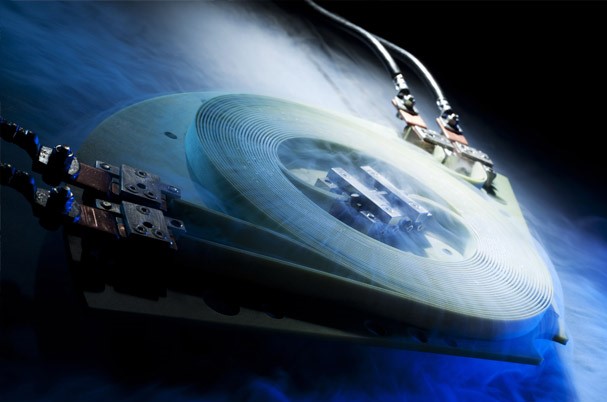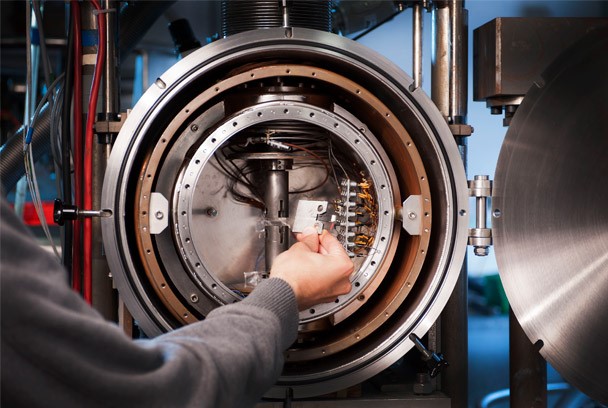How Mathias Noe wants to make the power supply in large cities fit for the future.
According to the United Nations, 1.6 billion people have no access to electricity. While population figures are rising worldwide, the development and expansion of a stable power supply is faltering. China itself invests billions in the construction for thousands of kilometers high-voltage lines every year. Also in Germany, the energy transition calls for modern, expanded grids. However, new lines are meeting with resistance: from Kiel to Freiburg, citizens are protesting against planned power lines and demanding that the high-voltage lines be laid underground. The problem: underground cables are more expensive and more complex. Superconductors could be part of the solution. Prof. Mathias Noe from KIT is working on making this complex technology usable.
Superconductors are materials that conduct electricity more efficiently at hundreds of times the current density. Higher efficiency due to lower losses and a compact design make them suitable for many applications. However, handling superconductors is complicated because they require cooling to below minus 183 degrees and the brittle material makes it difficult to manufacture cables that are ready for use.Together with industrial partners, Mathias Noe's research team is developing more cost-effective and robust second-generation high-temperature superconductor applications, for example based on yttrium-barium copper oxide. The goal: technical feasibility and cost-effectiveness.
"The investments that are being made in the technology at this stage will pay off long term."
Due to their characteristics, superconductors could become a decisive factor in Germany's energy transition. The basic problem: Wind and solar energy cannot currently be stored sufficiently and must therefore be consumed directly to the same extent as it is fed in. However, the distances between the places where energy is produced and where it is needed are sometimes very long, for example from the North Sea and Baltic Sea coasts to the major cities in southern Germany. This long transport requires not only more power lines than previously used, but also lower-loss cables. "Thanks to the new properties of superconducting equipment, for example transformers and lines, it is easier to integrate decentralized energy generators such as wind and solar plants into grids," Noe explains. But the alternative energy plants themselves could also benefit from superconductors, says the electrical engineer: "For example, wind turbine generators could be significantly smaller and at the same time more energy efficient."
In addition to the cables, suitable current limiters are also particularly important for the use of a 'superconductor power grid': they ensure that expensive power supply units are protected from irreparable damage in the event of short circuits and short-term overcurrents – an immense cost factor. "For the stability of medium- and high-voltage networks, superconducting current limiters offer a number of advantages," says Noe.
However, superconductor cables and superconducting current limiters can be used not only to expand a more stable and less expensive grid, but also when space is at a premium. This is an interesting advantage for large cities with many inhabitants in a small space. "In cities, power cables become a problem because the space available for them is hardly sufficient for the requirements. Superconductor cables are particularly suitable for confined spaces in inner cities because they are not only more powerful than conventional copper cables, but also require less space," explains superconductor expert Noe.
At the end of 2013, the Ruhr Valley city of Essen will pioneer such a new inner-city power supply: That's when the world's longest high-temperature superconductor cable with integrated current limiter will be laid underground. A modern 10,000-volt superconductor cable will replace the conventional 110,000-volt lines between two substations in downtown Essen over a length of one kilometer. Since the beginning of 2012, RWE Deutschland AG, Nexans as a manufacturer of cables and cable systems and KIT have been working on the realization of superconductivity in the city in the "AmpaCity" project funded by the German Federal Ministry of Economics and Technology. "The energy turnaround needs innovations. Due to the decision to phase out nuclear power, the energy industry, especially in Germany, is facing enormous challenges. Power generation, transport, distribution, storage and consumption have to be completely rethought in some cases. Particularly due to the scarcity of time, innovative solutions are needed here to solve the problems. The 'AmpaCity' project is an important building block for the energy-efficient power transmission of the future," says Essen's Lord Mayor Reinhard Paß in a statement on the construction project.
It could be the prelude to restructuring an inner-city network in completely new dimensions: After successful completion of a two-year field test, it would be conceivable to convert the backbone of Essen's distribution network largely to 10 kV superconductors and free it from high-voltage installations. In the medium term, this would lead to greater efficiency and lower operating and maintenance costs, while at the same time using less land. Valuable land would be freed up in the city center, as a number of substations could be dismantled. A positive side effect of buried superconductor cables is that they can withstand natural disasters for longer.
The explosive urbanization of recent decades shows that a space-saving, affordable and stable power supply is highly needed. Whether Istanbul, Rio or Bangalore – on all continents, especially in Asia and Africa, cities are getting bigger and bigger. In 2008, for the first time, more people worldwide lived in cities than in rural areas. The immense demand for electrical energy is rising globally, with experts forecasting a doubling by 2050.
The ever-increasing commitment of the energy industry demonstrates the potential of superconductor technology, says Noe: "The investments that are flowing into the technology at this stage will pay off long term."


